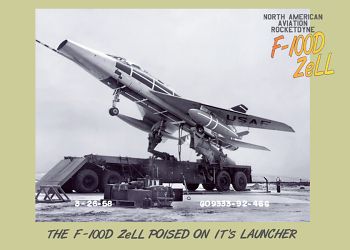
 |
It was an idea born out of the Cold War and the imminent threat of nuclear annihilation. A combat aircraft that wasn't restricted to an airfield could be moved anywhere and therefore survive the first moments of a nuclear exchange. The F-100 was capable of withstanding the launch forces while carrying an external fuel tank and a single nuclear weapon mounted on wing pylons. The pilot was expected to carry out his combat mission and either attempt to land at a friendly airfield or eject.
The rocket booster generated 132,000 pounds of thrust for four seconds, and at burned out when the F-100 reached an altitude of about 400 feet and a speed of 275 mph. The takeoff run (equal to the actual length of the ramp that guided the airplane during the initial instant of its launch) was approximately three-eighths of an inch, making it the world's shortest runway. During launch, the pilot experienced a maximum force of nearly 4 Gs.
The F-100 ZeLL project pilot was Albert W. Blackburn of North American Aviation. He made the first ZeLL flight on 26 March 1958 from the south end of Rogers Dry Lake at Edwards Air Force base, California.
After careful preparation, Blackburn ran the fighter's jet engine up to full power and pushed the launch button. As the booster blasted him into the sky, he held the wings level. Soon the rocket engine exhausted its fuel and dropped away. As it did, it struck the underside of the aircraft, causing slight damage. Otherwise, the flight was uneventful. Blackburn made a successful landing on the Edwards main runway.
